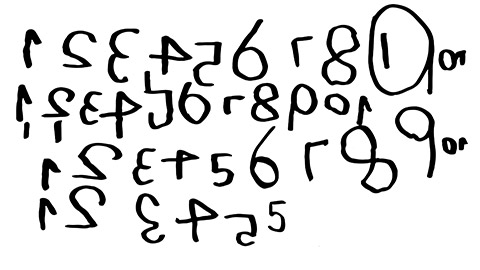Dysgraphia, like dyslexia, is a specific learning disability (SLD) that has a genetic tendency to run in families. It is a neurological disorder characterised by challenges in transcription, which includes the handwriting, typing, and spelling skills that allow us to produce writing.
Writing is slow and laborious for those with dysgraphia. Holding a pencil and organising words and numbers logically on a page or line can be challenging, resulting in messy handwriting.
Dysgraphia doesn't necessarily indicate a lack of oral language skills but rather the physical struggle to convert thoughts into written form.

The messy and illegible writing shown here in the photo may indicate dysgraphia.
Watch: What is Dysgraphia? Not just a Handwriting problem. How you can fix it. (3:53 minutes)
This next video provides an overview of dysgraphia, explaining the origins of the term and the challenges it presents, and emphasises that it's a brain-based issue. The video highlights that dysgraphia is not related to a child being lazy and explores how it affects the writing process.
Pre-Watch Question
Have you ever encountered or heard about dysgraphia before? What do you think might be some common challenges associated with dysgraphia based on the video's title?
Post-watch question
How does the video emphasise the importance of understanding dysgraphia, and what strategies are mentioned to assist children with dysgraphia in improving their writing skills?
The characteristics of dysgraphia encompass a range of difficulties related to writing and fine motor skills, including:
- Difficulty forming letters or numbers by hand.
- Slow handwriting development compared to peers.
- Illegible or inconsistent writing.
- Mixed upper- and lower-case letters.
- Difficulty writing and thinking at the same time.
- Difficulty with spelling.
- Slow writing speed, even when copying.
- Overreliance on vision to write.
- Poor spatial skills (uneven spacing, poor use of margins).
- Difficulty articulating thoughts in writing.
Dr Sheldon Horowitz is back again – this time exploring the meaning of dysgraphia, outlining its symptoms, and offering insights on how to support children with dysgraphia.
Watch: What is Dysgraphia? (6:10 minutes)
Pre-watch question
What do you currently know about dysgraphia and ways to support individuals with it?
Post-watch task
- Create a diagram that represents the three components of dysgraphia discussed in the video: visual-spatial, fine motor, and language processing.
- For each component, include:
- A title or heading (e.g., "Visual-Spatial Component").
- A brief description or definition of the component.
- Examples or scenarios that illustrate what difficulties in that component might look like. These can be based on the video or other relevant sources.
- Suggested strategies or solutions to assist children with dysgraphia in that particular component.

Numbers written by a child's hand in reverse and backward may also indicate dyslexia.
There are several different types of dysgraphia, and it is not uncommon for individuals to exhibit symptoms of more than one type. Symptoms may also vary among affected individuals.
- Dyslexic dysgraphia involves illegible spontaneous writing but relatively good, copied work, along with poor spelling. Fine motor skills are typically normal, and it may or may not co-occur with dyslexia.
- Motor dysgraphia is characterised by poor to illegible writing, even when copying. It results from deficient fine motor skills, poor dexterity, muscle tone issues, or motor clumsiness. Spelling skills are unaffected, but finger tapping speed is below normal.
- Spatial dysgraphia relates to difficulties in understanding spatial relationships. Individuals with spatial dysgraphia produce illegible spontaneous and copied writing. Spelling skills and finger-tapping speed are usually normal.
- Phonological dysgraphia involves difficulties in spelling unfamiliar words, non-words, and phonetically irregular words. People with this type of dysgraphia struggle to hold phonemes in memory and arrange them correctly.
- Lexical dysgraphia is characterised by correct spelling but relying on standard sound-to-letter patterns, leading to misspellings of irregular words. It's more common in languages like English and French and relatively rare in children.
Dysgraphia is a learning difficulty that significantly impacts a person's writing abilities, stemming from various factors such as fine motor skills, visual-spatial challenges, handwriting issues, spelling difficulties, word retrieval problems, and language processing issues.
Evaluation Tools for Dysgraphia
Identifying dysgraphia requires a comprehensive assessment that considers these diverse components, as it can result from a range of underlying learning issues. Therefore, a thorough evaluation involving multiple assessments is crucial to pinpoint the specific challenges an individual with dysgraphia faces in written expression.
Read the following article, which discusses various types of tests for dysgraphia, including those assessing mechanics of writing, thematic skills, and fine motor skills, emphasising their importance in identifying writing difficulties and potential accommodations for individuals with dysgraphia. Collect your own information about dysgraphia testing.
Reading
Types of Tests for Dysgraphia
Duration: 10 - 15 minutes
Pre-Read Question
Have you heard of any specific tests or assessments related to dysgraphia before reading this article?
Read the article from Understood here: Types of tests for dysgraphia.
Post-read Task
The following questions will help you gather all the essential information about what each test for dysgraphia assesses, why it's important, and how it works.
- What are the key areas that tests for dysgraphia assess?
- Why is it important to conduct a full evaluation when testing for dysgraphia?
- Can you provide examples of tests that assess the mechanics of writing, and what specific skills do they measure?
- What does the thematic assessment focus on, and why are thematic skills important?
- Describe the tests that assess fine motor skills and explain their significance.
- What happens after dysgraphia testing, and how are the results used to help individuals with dysgraphia?
- What are the key takeaways or main points regarding tests for dysgraphia, according to the article?
Dysgraphia is a learning difficulty that can pose significant challenges to children in their academic journey. However, with the right accommodations and support, these challenges can be reduced.
Check your learning here…
Occupational Therapy
Another effective way to assist children (and adults) with dysgraphia is through occupational therapy. This is especially beneficial for those who struggle with the fine motor aspects of writing. OT focuses on improving hand and body positioning, developing hand strength, and building motor skills that can make the act of writing less strenuous and painful.
The following videos feature Aidan, Lucy, and Sam, each sharing their unique experiences and challenges with dysgraphia. They highlight how age and developmental stages impact their struggles with writing and the strategies they employ to overcome them. Watch the videos and answer the accompanying questions.
Writing Challenges
Pre-watch question
Consider how dysgraphia might affect students at different grade levels, from elementary (primary) to high school.
Watch: Aidan, 1st Grade (2:41 minutes)
Watch: Lucy, 5th Grade (3:36 minutes)
Watch: Sam, 12th Grade (3:06 minutes)
Post-watch Task
In your notes, answer the following questions comparing the experiences of Aidan, Lucy, and Sam in dealing with dysgraphia.
- How do the ages and grade levels of Aidan, Lucy, and Sam impact their respective challenges with dysgraphia?
- What common frustrations do Aidan, Lucy, and Sam share when it comes to writing, and how do these frustrations differ based on their ages and stages of education?
- Compare the coping mechanisms Aidan, Lucy, and Sam use to deal with their dysgraphia. How do these strategies evolve as they advance through different stages of schooling?
- Explore how the support and accommodations mentioned in the videos vary for Aidan, Lucy, and Sam. How do these accommodations align with their developmental stages?
- In what ways do Aidan, Lucy, and Sam find joy or satisfaction in writing despite their challenges? How do their attitudes towards writing differ based on their ages?
- Dysgraphia, a genetic SLD, involves challenges in transcription, affecting handwriting, typing, and spelling.
- Characteristics include slow, messy handwriting, difficulty organising text, poor fine motor skills, and challenges in translating thoughts into writing.
- Dysgraphia types include dyslexic, motor, spatial, phonological, and lexical, each with specific characteristics.
- Identifying dysgraphia involves assessing diverse factors such as fine motor skills and language processing.
- Accommodations, including occupational therapy, play a vital role in alleviating challenges and supporting individuals with dysgraphia.
- Case studies highlight age-specific challenges and coping mechanisms of individuals and the impact of family support in overcoming dysgraphia challenges.
